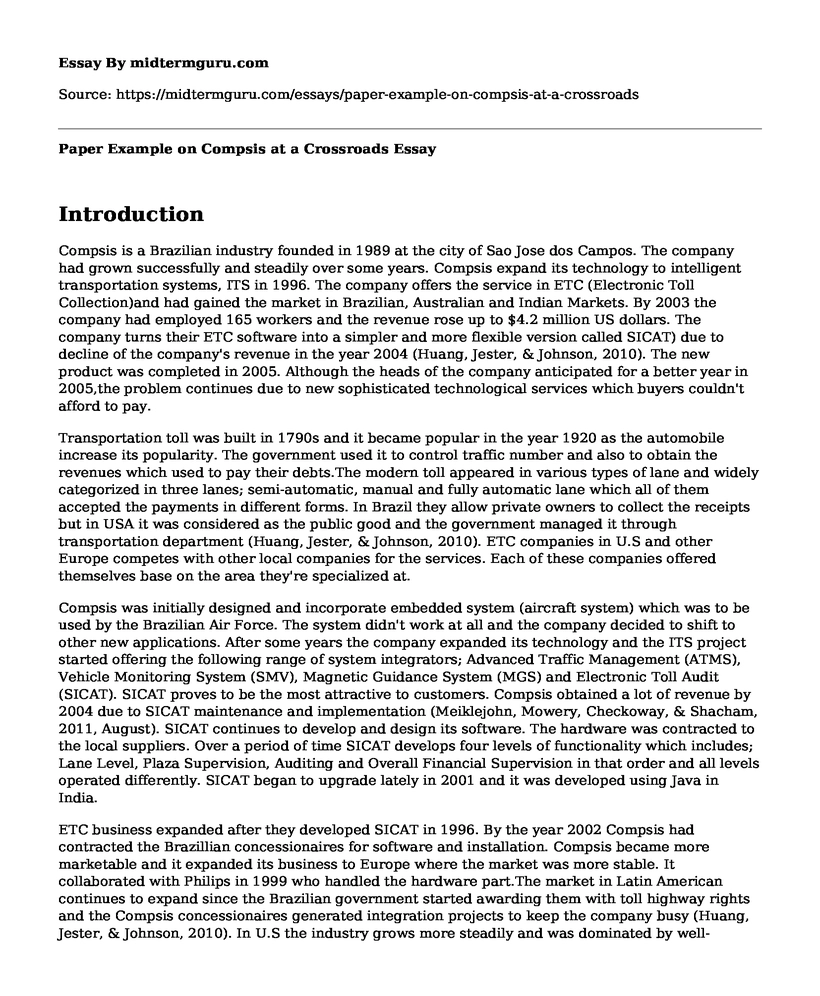Introduction
Compsis is a Brazilian industry founded in 1989 at the city of Sao Jose dos Campos. The company had grown successfully and steadily over some years. Compsis expand its technology to intelligent transportation systems, ITS in 1996. The company offers the service in ETC (Electronic Toll Collection)and had gained the market in Brazilian, Australian and Indian Markets. By 2003 the company had employed 165 workers and the revenue rose up to $4.2 million US dollars. The company turns their ETC software into a simpler and more flexible version called SICAT) due to decline of the company's revenue in the year 2004 (Huang, Jester, & Johnson, 2010). The new product was completed in 2005. Although the heads of the company anticipated for a better year in 2005,the problem continues due to new sophisticated technological services which buyers couldn't afford to pay.
Transportation toll was built in 1790s and it became popular in the year 1920 as the automobile increase its popularity. The government used it to control traffic number and also to obtain the revenues which used to pay their debts.The modern toll appeared in various types of lane and widely categorized in three lanes; semi-automatic, manual and fully automatic lane which all of them accepted the payments in different forms. In Brazil they allow private owners to collect the receipts but in USA it was considered as the public good and the government managed it through transportation department (Huang, Jester, & Johnson, 2010). ETC companies in U.S and other Europe competes with other local companies for the services. Each of these companies offered themselves base on the area they're specialized at.
Compsis was initially designed and incorporate embedded system (aircraft system) which was to be used by the Brazilian Air Force. The system didn't work at all and the company decided to shift to other new applications. After some years the company expanded its technology and the ITS project started offering the following range of system integrators; Advanced Traffic Management (ATMS), Vehicle Monitoring System (SMV), Magnetic Guidance System (MGS) and Electronic Toll Audit (SICAT). SICAT proves to be the most attractive to customers. Compsis obtained a lot of revenue by 2004 due to SICAT maintenance and implementation (Meiklejohn, Mowery, Checkoway, & Shacham, 2011, August). SICAT continues to develop and design its software. The hardware was contracted to the local suppliers. Over a period of time SICAT develops four levels of functionality which includes; Lane Level, Plaza Supervision, Auditing and Overall Financial Supervision in that order and all levels operated differently. SICAT began to upgrade lately in 2001 and it was developed using Java in India.
ETC business expanded after they developed SICAT in 1996. By the year 2002 Compsis had contracted the Brazillian concessionaires for software and installation. Compsis became more marketable and it expanded its business to Europe where the market was more stable. It collaborated with Philips in 1999 who handled the hardware part.The market in Latin American continues to expand since the Brazilian government started awarding them with toll highway rights and the Compsis concessionaires generated integration projects to keep the company busy (Huang, Jester, & Johnson, 2010). In U.S the industry grows more steadily and was dominated by well-developed providers.Most public organizations in U.S handled the ETC project. Roads were also operated and constructed by the same public organizations.
Sales process of ETC in the U.Sgot procured early1990s; most trade organizations come together and provided them with services which exposed to potential customers.Compsis enters the U.S market through partnering with United States firm like transportation industry, opening their sales office that needed to hire engineers and sales staffs and by collaborating with a well-known construction company in U.S. mainly those who had built the toll road.
References
Huang, Y., Jester, M., & Johnson, S. (2010). Reading Global Entrepreneurship Lab Asia-Pacific Course.
Meiklejohn, S., Mowery, K., Checkoway, S., &Shacham, H. (2011, August). The Phantom Tollbooth: Privacy-Preserving Electronic Toll Collection in the Presence of Driver Collusion. In USENIX security symposium (Vol. 201, No. 1, pp. 1-16).
Cite this page
Paper Example on Compsis at a Crossroads. (2022, Sep 07). Retrieved from https://midtermguru.com/essays/paper-example-on-compsis-at-a-crossroads
If you are the original author of this essay and no longer wish to have it published on the midtermguru.com website, please click below to request its removal:
- Evaluation Essay on Starbucks Company
- The Reasons for Sustainability of Toyota Company - Paper Example
- Paper Example on Ethical Management
- Maximising Financial Assets in Care South Group - Essay Sample
- Ascena Strategy of Acquisition - Research Paper
- Netflix: Ethical Business Standards and Recruiting Sales Representatives - Research Paper
- Nestle: Transnational Nutrition & Health Giant in Australia - Essay Sample







